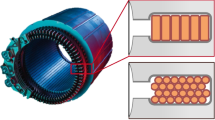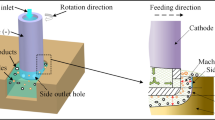Abstract
Vitrified bonded cBN grinding wheels catches on for batch production especially in the automotive industry for components of power trains. In pursuit of higher productivity with steady quality the optimization of manufacturing processes and tools are getting more relevant. In this contribution potentials and challenges of structured grinding tools for the optimization of grinding processes are discussed. Technological investigations with structured and non-structured vitrified bonded cBN grinding wheels were carried out and the results of varying setting parameters were analyzed. The main aspects of interest for these studies were the detection of possible coolant savings and phenomena of vibrations, the reduction of the thermal damage of the workpieces as well as the influence on the workpiece roughness and the grinding wheel radial wear. The experiments show the potentials of structured cBN grinding wheels for roughing and finishing in cylindrical plunge grinding processes. But there are some basic requirements for the geometry of the structures especially due to the vibrations of the grinding process. For the roughing tests the adequate structured abrasive layers show less grinding forces and thermal damage of the workpiece. For finishing processes the results show comparable values of roughness and waviness referring to non-structured grinding wheels. In addition, a limit for suitable grinding wheel structures in conjunction with the setting parameters could be identified that offers valuable clues for the dimensioning of structured abrasive layers even for non-circular grinding processes.











Similar content being viewed by others
References
Uhlmann E, Mewis J, Kirchgatter M (2010) Dynamiksimulation von Schleifprozessen. wt Werkstattstechnik online 100(1/2):53–61
Uhlmann E, Mewis J, Hochschild L (2010) Analyse von Schleifprozessen mit genuteten Schleifscheiben. wt Werkstattstechnik online 100(6):494–501
Uhlmann E, Sammler C (2010) Ressourceneffizientes Schleifen—Lösungen und Grenzen. In: Tawakoli T (ed) Moderne Schleiftechnologie und Feinstbearbeitung. Vulkan, Essen, pp 2-1–2-15
Kirchgatter M (2010) Einsatzverhalten genuteter CBN-Schleifscheiben in keramischer Bindung beim Außenrund-Einstechschleifen. Dissertation, TU, Berlin
Uhlmann E, Kirchgatter M (2009) Technologischer Nutzen von Schleifbelagsnutungen. wt Werkstattstechnik online 99(6):390–395
Tawakoli T, Lee DH (2012) Außenrund-Trockenschleifen, neue Erkenntnisse. In: Tawakoli T (ed) Moderne Schleiftechnologie und Feinstbearbeitung. Vulkan, Essen, pp 4c-1–4c-16
Nguyen T, Zhang LC (2009) Performance of a new segmented grinding wheel system. Int J Mach Tools Manuf 49(3/4):291–296
Aurich JC, Herzenstiel P (2008) High-Performance dry grinding using a grinding wheel with a defined grain pattern. CIRP Ann Manuf Technol 57(1):357–362
Lee KW, Wong PK, Zhang JH (2000) Study on the grinding of advanced ceramics with slotted diamond wheels. J Mater Process Technol 100:320–325
Ziebuhr T, Goldbach J, Niebuhr M, Neumann J, Rennert L (2007) ABC der Schleiftechnik. Krebs and Riedel Schleifscheibenfabrik GmbH and Co. KG, Bad Karlshafen
Brinksmeier E (1991) Prozeß- und Werkstückqualität in der Feinbearbeitung. Habilitation, Universität Hannover
Gorgels C (2011) Entstehung und Vermeidung von Schleifbrand beim diskontinuierlichen Zahnflankenschleifen. Dissertation, RWTH Aachen
Klocke F (2005) Schleifen. In: Klocke F, König W (eds) Fertigungsverfahren 2, 4th edn. Springer, Berlin, pp 155–342
Werner G (1971) Kinematik und Mechanik des Schleifprozesses. Dissertation, RWTH, Aachen
Acknowledgments
The presented results originate from the project “Einfluss der Segmentierung von Schleifscheiben aus das Arbeitsergebnis beim Rundschleifen” (Uh 100/86-2) funded by the “Deutsche Forschungsgemeinschaft” (DFG).
Author information
Authors and Affiliations
Corresponding author
Rights and permissions
About this article
Cite this article
Uhlmann, E., Hochschild, L. Tool optimization for high speed grinding. Prod. Eng. Res. Devel. 7, 185–193 (2013). https://doi.org/10.1007/s11740-013-0447-5
Received:
Accepted:
Published:
Issue Date:
DOI: https://doi.org/10.1007/s11740-013-0447-5




